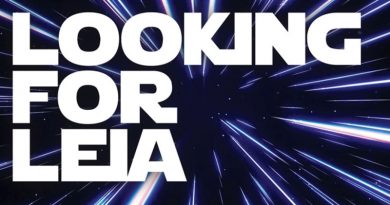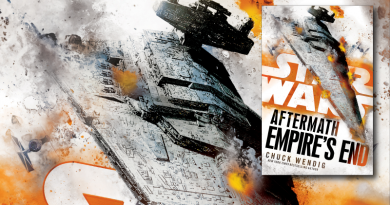REVIEW: The Art of Star Wars: Galaxy’s Edge

Last week marked the publication of The Art of Star Wars: Galaxy’s Edge, the latest in a series of tomes from Abrams showcasing concept art and behind-the-scenes elaboration from the development of recent Lucasfilm projects, including five theatrical films and The Mandalorian Season One. Written by Amy Ratcliffe, the book follows a similar format and presentation style to those volumes – but stands unique in exploring the artistic origins of a theme park expansion land rather than a cinematic story. The extensive collaboration between Lucasfilm and Walt Disney Imagineering is emphasized throughout, beginning in the foreword by Scott Trowbridge, the portfolio creative executive who oversaw the development of Galaxy’s Edge from conception and design to construction and execution in two Disney Parks.
After Disney acquired Lucasfilm in late 2012, the group conducting the initial blue-sky creative brainstorming for the project began its work in April 2014. Then-CEO Bob Iger officially announced the expansions at D23 Expo in August 2015; they opened to guests in 2019, on May 31 at Disneyland in Anaheim and on August 29 at Hollywood Studios in Orlando. (After being open less than ten months, Galaxy’s Edge at Disneyland closed for over thirteen months due to the COVID-19 pandemic; Disney World ceased operations for four months in 2020 before reopening at reduced capacity.)
In the four year of waiting for the highly anticipated grand openings, the Imagineers and Lucasfilm shared updates and concept art at convention panels and special events at the Parks. (Links to our FANgirl Blog coverage are included below.) For the relatively small number of fans who followed the details of such news closely, much of the behind-the-scenes prose content in The Art of Galaxy’s Edge will be familiar, such as quotes from Imagineers including Margaret Kerrison, Asa Kalama, and Chris Beatty and Lucasfilm executives Carrie Beck, Pablo Hidalgo, Matt Martin, and Doug Chiang. For everyone else, the book pulls back the curtain in much the same way that the other Art of books offer previously unrevealed insights into the artistic and storytelling decisions in the production of the films.
Regardless of one’s prior knowledge of the development process, The Art of Star Wars: Galaxy’s Edge unveils hundreds of images that had never been shared publicly before. They vary from the macro-level design of the overall appearance of the area to honing in the specific details on signage for particular shops within the marketplace. Each major location in Black Spire Outpost is featured, including both theme park rides (Millennium Falcon: Smuggler’s Run and Rise of the Resistance), the popular spots to visit (Oga’s Cantina, Dok Ondar’s Den of Antiquities, and Savi’s Workshop), the food vendors (Ronto Roasters and Docking Bay 7), and more. The book also contains concept art for ideas that did not make the final version of the land, such as a swanky table-service restaurant and having the creature vendor be less a shopkeeper than a zookeeper (complete with a rancor in a pit). The comments from artists and Imagineers explain that some ideas were discarded due to impracticability or cost, while others dropped away as the development process evolved.
At times, it seems as though the Imagineers became so entrenched in their own vision for the land that they did not always pause to consider the perspective of a casual Disney Parks guest (or casual Star Wars fan) undertaking a simple escapist day at a theme park rather than an immersive adventure of the imagination. For example, comments from multiple individuals emphasize the idea of guests discovering things for themselves in the land – that the secret Resistance base should be something you have to seek out, rather than easily find; that the entrance to Oga’s Cantina might be a nondescript portal suitable for an underworld speakeasy; that the iconic Millennium Falcon (code name “Big Bird”) should not be an obvious centerpiece of the land but something to be found by exploring your way through the outpost. Imagineering executive Scott Mallwitz recounts that Iger “looked at the model of the land in progress and said, ‘Do me a favor. Just don’t bury the bird. [B]ecause it looked like in our model it was buried. We were conscious of that note the whole way through.” Mallwitz adds, “It was a counterbalance between Bob’s note and our premise about discovering your own adventure. We were balancing that the whole time in design.” While the explanations offered in the book make sense from the Imagineers’ premises, it is less clear how much debate – and, more importantly, how much theme park guest experience data – went into the decision to ground the land in those premises rather than potentially more widely shared alternatives.
Several similar themes recur throughout the book. First, the design team clearly took to heart their permission from Iger to “Be ambitious!” While the end result was constrained by what could reasonably be implemented in theme parks open to guests 365 days a year, the art demonstrates how big the team was willing to dream – including the decision to create a brand new setting in the Star Wars galaxy for the theme park land, rather than a known location from the feature films. Second, one of the guiding principles for the Imagineers was that “each guest could become more of a participant rather than a spectator” in an immersive Star Wars experience, while ensuring that “this engagement had to feel like an invitation, not an obligation” during a visit to Black Spire Outpost. The degree of attention to detail paid to all aspects of the land readily comes across in these pages. Third, from start to finish the setting of Black Spire Outpost was situated in Star Wars not as a place to visit, but as a story to enter. The artwork shows how this idea influenced everything from the histories of the outpost and its residents to selecting an in-universe timeline placement for the rides and the character interactions.
After having visited Black Spire Outpost on multiple occasions, and observing the reactions and interactions of hardcore Star Wars fans and other Disney Parks guests alike, it is easy to see how these themes in The Art of Galaxy’s Edge play out in the real world. For some guests, the idea of living their own new Star Wars adventure is a thrill; for others, the lack of nostalgic familiarity makes Batuu underwhelming. Some guests notice the intricate craftsmanship, hidden Easter Eggs, and ambient sounds and dialogue; others are oblivious, treating a food stand or ride queue in Galaxy’s Edge as no more special than one in Fantasyland or Sunset Boulevard. Finally, within the Parks just as outside them, the strong feelings generated by The Last Jedi and The Rise of Skywalker cannot simply be set aside. One can wonder how the extant iteration of Black Spire Outpost might be received had the overall reception of the Sequel Trilogy among the entire aggregate audience been more favorable – but in my experience, at least, it is noticeable how much less enthusiasm for character interactions is to be found with Kylo Ren, Rey, and Vi Moradi (who most Parks guests are entirely unaware of) as compared to Darth Vader, Leia and Luke, Anakin and Padmé, or Ahsoka and Captain Rex at Star Wars Weekends from 2010 to 2015. Chewbacca, at least, always draws a crowd no matter the Park or year, and that remains true in Galaxy’s Edge, as well.
Related Links
- Star Wars Celebration Orlando 2017: Disney Parks Star WarsExperiences (Apr. 2017)
- Pandora – The World of Avatar Previews Star Wars: Galaxy’s Edge at Disney Parks (Sep. 2017)
- Star Tours: New Characters and Locations Mark Narrative Shift To Ride (Nov. 2017)
- Star Wars: Galaxy’s Edge Preview at Galactic Nights (Dec. 2017)
- At Galaxy’s Edge, Choose Your Own Adventure (Jun. 2018)
- Star Wars Celebration Chicago 2019: Bringing Star Wars: Galaxy’s Edge to Life at Disney Parks (Apr. 2019)
- Bright Suns: Inside The Art of Star Wars: Galaxy’s Edge – Exclusive Preview (StarWars.com; Apr. 23, 2021)










